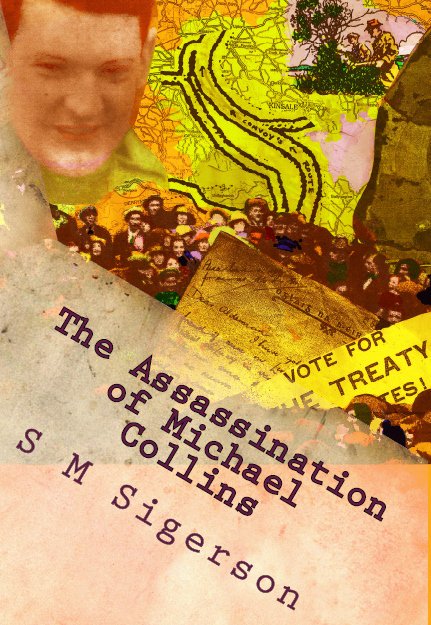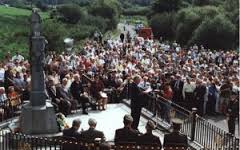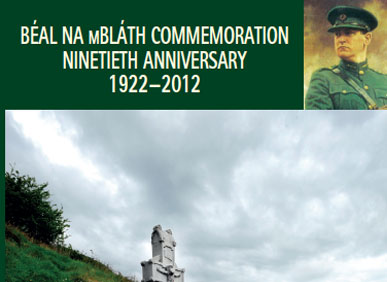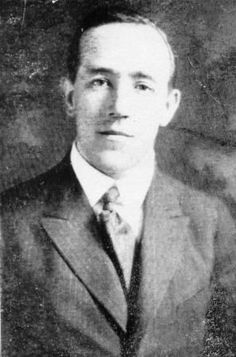
“The Murder of Michael Collins” is an online video by Paddy Cullivan; as well as a live performance piece. See www.paddycullivan.com for details, tickets, links, and itinerary. While this writer cannot completely concur with his analysis in every point, his presentation is extraordinary, in every sense of the word; and merits extraordinary notice.
If you want to tell people the truth, you’d better
make them laugh, or they’ll kill you.
– George Bernard Shaw
For those familiar with musical satirist Paddy Cullivan’s unique approach to Irish history, he needs no introduction; and… the very idea of the death of Collins in his hands is rather mind-boggling… fascinating… if not frightening! Still, quintessentially Irish, in his wry determination to stare down the bottomless travesties there, until they yield their reducto ad absurdum. Cullivan uses tears of laughter like a magic prism, enabling us to explore these agonies & ecstasies, triumphs & tragedies to new depths. Which perhaps we might never reach, without the liberating and envigorating tonic of humour.
My own book, The Assassination of Michael Collins: What Happened at Béal na mBláth?, www.amazon.com/dp/1493784714 was the first on this subject since John M Feehan’s landmark edition of 1991 (The Shooting of Micheal Collins: Murder or Accident?) My highest ambition, in writing it, was to build on Feehan’s work: like him, not to “sell” any one theory, but to help people study the case. To enable the public and future researchers to better examine the evidence fully, for themselves.
Since publishing it, I’ve waited, sometimes breathlessly, for the appearance of other new works on the topic to follow; especially as the 2022 Centenary of Collins’ death wp.me/p43KWx-96 drew nearer.
I hoped to see other works take up the tale in the same spirit; which would be penetrating, disinterested, disciplined, and illuminating.
Well, many are called, but few are chosen. Down the ages, discoveries of note have sometimes emerged from surprising places. I confess I’ve been pleasantly surprised to find more research of value, and more interesting analysis, in Cullivan’s persuasive pastiche of lecture, lampoon, & song, than can hardly be found in any work on the death of Collins to appear since my own. All of this richly illustrated with rare visuals from the period; including copies of orginal historical documents; some aired here for the first time.
Let me write a nation’s songs, and I care not who writes its laws. – Daniel O’Connell
Cullivan’s original songs for the show, and masterful music production, deserve air play of their own. I hope music radio is listening. In Ireland, his catchy pop broadside “Béal na Blah Blah Blah” https://youtu.be/Z9CvohYT-b0 could and should go right up the charts; especially for the 2022 Centenary year. Cullivan is a first-class musician, well-known (in Ireland) as vocalist, songwriter, multi-instrumentalist, & producer. (Glad I’ve lived to see the day when performing artists can have their work in other fields taken seriously, such as in literature or politics.)
Cullivan manages also to make his video a kind of bibliography on the topic, giving on-screen space to a crowded bookshelf of sources. (While his particular comments on The Assassination of Michael Collins: What Happened at Béal na mBláth?, www.amazon.com/dp/1493784714 far exceed expectations, they could never win from the author any praise for Cullivan’s work, but that most richly deserved.)
Who IS Paddy Cullivan…?
History is a scholarly pursuit, but not an exact science. Proper academic researchers have been known to protest the popularity of mere mortals, with no letters after their names, poaching on their domains, so to speak. Raising the inevitable question:
Who IS Paddy Cullivan to dare trespass where academics have feared to tread in this history?
The truth is, institutions often fail us. Nowhere more spectacularly than in the death of Michael Collins.
That doesn’t mean we can do without them. Institutions are necessary. Expertise is necessary. The public needs protection from critical decisions & information affecting society being handed out by any Joe Blow, whether they have a clue or not.
At the same time, institutions are made by humans, run by humans; and therefore subject to all the usual human frailties. They cannot be treated like infallible deities.
Institutions are created to serve, not rule, humanity. Therefore they must continually satisfy the public that they’re doing their jobs. Admittedly, this can be problematic: how does the public judge experts’ performance, in areas where they have less expertise than the experts whom they must monitor? Not only in academic studies, but in such critical organs as law, government, medicine, science? These epistemological questions are at the heart of countless current controversies, as we speak.
Thankfully, experts’ work must be subject to constant peer review; as well as the universal tribunal of common sense. While these, too, can err, it’s the best we can do. Human society & human institutions are subject to these eternal margins of error, which we must all bear in mind.
This is precisely why the voice of Joe Blow is not without its place and value. Just as the innocent, uninitiated, uninformed may sometimes be the only one to step forward and candidly exclaim, “Look! The Emperor has no clothes!”
History is a field particularly vulnerable to such pot-shots from the peanut gallery of inquiry, so to speak. It is a field in which we are all swimming, all immersed; which we are all living with the profoundest consequences of, every day. It’s an area of study in which innovative, multi-disciplinary approaches may prove remarkably effective; especially where an “official story” regime has managed to stifle institutions.
I challenge any academic researcher to take in Cullivan’s work, to excel it, or even… to avoid relying on it!
But above all to explain how and why academics have managed to so completely fail and neglect the elephant in the room of modern Irish history: the death of Commander-in-Chief Michael Collins, erstwhile Chairman of Dublin’s first native Provisional Government… So as to leave it to be unearthed by the likes of your humble servant; and by such as the inimitable Paddy Cullivan… who at this time stands in serious danger of… becoming an Historian!
Look out for his personal appearances, bringing the live version of “The Murder of Michael Collins“, and other shows, to a venue near you.
Read more
“The Assassination of Michael Collins:
What Happened At Béal na mBláth?”
http://www.amazon.com/dp/1493784714
by S M Sigerson
Paperback or Kindle edition here:
www.amazon.com/dp/1493784714
All other e-reader formats:
www.smashwords.com/books/view/433954
Read reviews:
http://www.rabidreaders.com/2014/12/03/assassination-michael-collins-s-m-sigerson-2/
Or ask at your local book shop



































